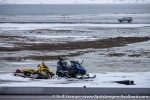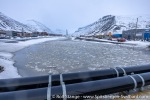-
current
recommendations- Liefdefjord
New page dedicated to one of Spitsbergen's most beautiful fjords. Background information and many photos.
- New Spitsbergen guidebook
The new edition of my Spitsbergen guidebook is out and available now!
- Liefdefjord
New page dedicated to one of Spitsbergen's most beautiful fjords. Background information and many photos.
Seitenstruktur
-
Spitsbergen-News
- Select Month
- April 2024
- March 2024
- February 2024
- January 2024
- December 2023
- November 2023
- October 2023
- September 2023
- August 2023
- July 2023
- June 2023
- May 2023
- April 2023
- March 2023
- February 2023
- January 2023
- December 2022
- November 2022
- October 2022
- September 2022
- August 2022
- July 2022
- June 2022
- May 2022
- April 2022
- March 2022
- February 2022
- January 2022
- December 2021
- November 2021
- October 2021
- September 2021
- August 2021
- July 2021
- June 2021
- May 2021
- April 2021
- March 2021
- February 2021
- January 2021
- December 2020
- November 2020
- October 2020
- September 2020
- August 2020
- July 2020
- June 2020
- May 2020
- April 2020
- March 2020
- February 2020
- January 2020
- December 2019
- November 2019
- October 2019
- September 2019
- August 2019
- July 2019
- June 2019
- May 2019
- April 2019
- March 2019
- February 2019
- January 2019
- December 2018
- November 2018
- October 2018
- September 2018
- August 2018
- July 2018
- June 2018
- May 2018
- April 2018
- March 2018
- February 2018
- January 2018
- December 2017
- November 2017
- October 2017
- September 2017
- August 2017
- July 2017
- June 2017
- May 2017
- April 2017
- March 2017
- February 2017
- January 2017
- December 2016
- November 2016
- October 2016
- September 2016
- August 2016
- July 2016
- June 2016
- May 2016
- April 2016
- March 2016
- February 2016
- January 2016
- December 2015
- November 2015
- October 2015
- September 2015
- August 2015
- July 2015
- June 2015
- May 2015
- April 2015
- March 2015
- February 2015
- January 2015
- December 2014
- November 2014
- October 2014
- September 2014
- August 2014
- July 2014
- June 2014
- May 2014
- April 2014
- March 2014
- February 2014
- January 2014
- December 2013
- November 2013
- October 2013
- September 2013
- August 2013
- July 2013
- June 2013
- May 2013
- April 2013
- March 2013
- February 2013
- January 2013
- December 2012
- November 2012
- October 2012
- September 2012
- August 2012
- July 2012
- June 2012
- May 2012
- April 2012
- March 2012
- February 2012
- January 2012
- December 2011
- November 2011
- October 2011
- September 2011
- August 2011
- May 2011
- April 2011
- March 2011
- February 2011
- January 2011
- December 2010
- November 2010
- September 2010
- August 2010
- July 2010
- June 2010
- May 2010
- April 2010
- March 2010
- February 2010
- November 2009
- October 2009
- August 2009
- July 2009
- June 2009
- May 2009
- April 2009
- March 2009
- February 2009
- January 2009
- December 2008
- November 2008
- October 2008
- August 2008
- July 2008
- June 2008
- May 2008
- April 2008
- March 2008
- February 2008
- April 2000
- Select Month
-
weather information

| THE Spitsbergen guidebook |
Home →
Yearly Archives: 2022 − News
Polar bears disturbed by tourists “around the clock”?
The first “normal” – without major disturbance by Covid19 – summer season in Spitsbergen has begun. Actually, the winter has just started to loosen its icy grip, the islands are still largely snow-covered, many fjords still frozen and there is currently quite a lot of drift ice on the north and east coasts of Svalbard.
But cruise ships have started trips of several days already weeks ago, and the first ship-based day-trips out of Longyearbyen were offered as early as March. It is not that long ago that the winter season (no ships) lasted until around mid May, then there was a break of several weeks with little activity during the snowmelt and then the summer which involved ship-based activity started in June. But that is history, tour operators are starting earlier and earlier every year, some as early as March.
Now, around mid May, there are already several dozen tourist vessels cruising Spitsbergen’s coastal waters, and there is already trouble although most of them have just started their season. There are photos circulating on social media showing close encounters of polar bears on ice and tourists on ships, and the public discussion is in full swing. The issue is already covered by NRK, Norway’s most important news platform. The headline of the linked-up article claims that Svalbard’s polar bears are disturbed by tourists “around the clock”.
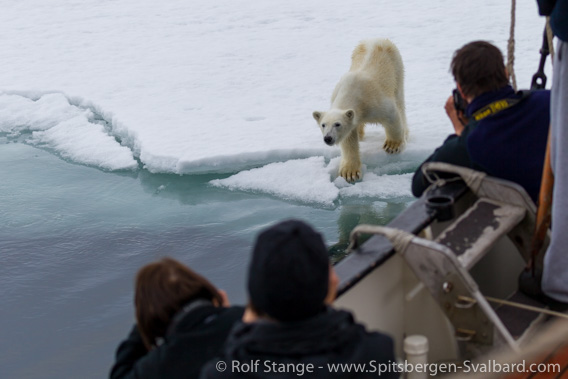
Polar bear on ice close to a ship: who moved to visit the other part? Who was chased, disturbed or even put at risk? Maybe: noone. (Archive image, 2015).
The current discussion is fuelled by photos like this one, showing polar bears and ships with tourists in close distance. There have been situations like that also in recent weeks in Spitsbergen, photos are circulating and the discussion is going high. A reaction may also come from official side: the Sysselmester (governor) has announced to investigate relevant cases.
There is no doubt: violation of valid law, written and unwritten, and unethical behaviour, are inacceptable and should be followed by strictly by the authorities, involving fines wherever appropriate.
Illegal behaviour, unethical action or acceptable behaviour?
But the question is if it is really as easy as that. It seems so: many public commentators including journalists (NRK) take it as given that the polar bears are disturbed by tourists, even “around the clock”. But what does a picture like the one above actually show? The actual picture that has fuelled the current debate has, by the way, been removed from social media posts by the photographer. But it shows – from the perspective of another, not directly involved ship – a situation very similar to the one in the picture above. So, is a situation like this a problem, maybe even legally relevant, or not?
Over the years, I have been in situations like this one a number of times: a ship is parked at the ice edge or between ice floes. A polar bear gets a sense of the ship. Often being a curious and inquisitive animals, chances are that the bear comes closer to inspect the object of his (or her) curiosity. The bear may come close enough to even touch the ship, sniffing on the hull, while the people on board are taking pictures, and then walks his (her) way again. (I highlight “her” because both males and females may show curious and inquisitive behaviour).
It is, of course, hard to say what actually happened in any given case unless you have been there and seen it. Hardly anyone who is contributing to the current discussion has been there. In this given case, I have coincidentally been close enough to see a few bits and pieces (more on that below), but too far to see any details. Generally speaking, a wide range of scenarios is possible: did the people on board to something to attract the bear actively? Did they even feed it? Both is prohibited and completely inacceptable, there is no room for discussion about this. But unless there is any information that points towards such behaviour, there is no no need to assume that anything like that has actually happened: the presence of a ship, not moving, may well be enough to work up a polar bear’s curiosity; after all, being curious is natural behaviour for a polar bear, and this is often reason enough for a polar bear to come close and check out a ship (or hut or tent). This is not at all unusual and it is not condemnable. Neither is it unethical as long as the people on board don’t take any innapropriate action and as long as there is no danger for man or beast (people on board a ship a generally safe – which again means that also the bear is safe – unless the ship is so small that a bear can jump on board; something that would, however, be a very unusual behaviour. I have never heard of a polar bear jumping on a boat with people on deck). Also from a legal viewpoint, there shouldn’t be anything to complain about: §30 of the Svalbard environmental act prohibits any action to “attract polar bears, to feed them, to follow them or to seek out a polar bear actively in such a way that may involve a disturbance of the polar bear or that may put humans or the polar bear at risk” (my own translation). It should not hard to understand that none of these actions – or equivalent ones – need to be involved when a ship stands still and a polar bear decides out of curiosity to come close.
So, is everything fine then?
As mentioned above, of course it is possible to think of scenarios that involve unacceptable and even illegal behaviour. But this appears unlikely in the given recent case, where the ship was parked in the ice. As mentioned above: I was too far to see any details of what people on board were doing, but close enough to notice that the boat in question was not moving for hours. It was not actively moving anywhere.
It is, by the way, not a realistic scenario for a boat to follow a polar bear in dense ice; even at a relaxed pace, a polar bear will be more than fast enough to just walk away unless it is a strong ship that can push or even break ice at speed (breaking ice is, by the way, also generally forbidden).
Snow mobiles on fjord ice may – given unethical behaviour of the driver – be a different thing, but for that reason motorised traffic on fjord ice has been largely banned in relevant fjords already for years. Also fast motor boats in open water may easily be used in ways that can cause great disturbance to polar bears. Unfortunately, we have to assume that not everybody has enough common sense and relevant knowledge to behave appropriately: stopping immediately as soon as the bear shows the slightest sign of feeling uneasy about the presence of boats and moving away carefully without delay when necessary. In such a situation, any further approach that would involve disturbance is forbidden by law as it as been in force since 2001 (Svalbardmiljøloven).
Back to the given case: there is nothing to see or to read in photos and information publically available that points towards such behaviour. NRK journalist Rune N. Andreassen claims that polar bears in Svalbard are disturbed by tourists “around the clock”. His article (link above) does not provide information which would actually indicate this. It appears that the headline supports the same public opinion that it may well be derived from (rather than factual information): the combination of tourists and polar bears is generally bad, and if both are close together, it is just assumed that this is not acceptable and probably illegal.
It is clear that photos like the ones in question that are (were) circulating on social media easily give rise to a heated public discussion, especially when the viewer has never made a similar experience him- or herself, observing the actual event from the beginning to the end. Maybe the authors of articles such as the above-mentioned one on the NRK website have information that I don’t have, but I doubt it. It would be good to have solid information to base one’s opinion on when voicing such a strong statement such as a claim of polar bears being disturbed by tourists “around the clock” (or at all). Especially in nationwide media, but also elsewhere.
And especially when it comes at a time of a heated political debate: Norwegian legislative authorities are currently considering – amongst many other things – a legal requirement to keep a general minimum distance of 500 (five hundred) metres from polar bears under any circumstances.
Rather than letting a polar bear carry on with following his (or her, for that sake) curiosity even if it does not involve any risk or disturbance, this would mean that you would have to start moving your boat or even use deterrents such as a flare gun. Both options are much more likely to disturb the animal than just staying where you are as long as everybody and everything is safe. Something that will generally be the case as long as people are on the ship and the polar bear is on the ice. And this is what we are talking about. Nothing else.
By the way, NRK author Andreassen uses in his article (links above) a photo taken by a Norwegian Polar Institute field biologist, taken “from a proper distance” according to the comment under the photo. I would estimate the distance between the photographer and the two bears in this photo to be somewhere near 50 metres. On tenth of what Norwegian legislative authorities currently are considering as a legally binding minimum distance for polar bear encounters.
National day celebrations without children from Barentsburg
The 17th of May is the Norwegian national day and it is celebrated everywhere in the country with great enthusiasm and a lot of public attention and activities.
In Longyearbyen, this usually includes the tradition to invite representatives from the Russian settlement of Barentsburg, only 40 kilometres away from Longyearbyen. Representatives from the mining company Trust Arcticugol and the consulate came as well as children who met the local children in Longyearbyen.

Representatives from Barentsburg holding speaches next to the Sysselmannen (now: Sysselmester) and the mayor of Longyearbyen on the 17th of May (here in 2019).
It had been made clear in advance that official representatives would not be welcome this year, but the children and “necessary entourage” were invited. Their visit was, however, cancelled by Barentsburg after “internal discussions”, according to Svalbardposten As a consequence, there was no meeting between the neighbours Barentsburg and Longyearbyen in the context of the 17th of May 2022. The original idea that the Russian and Ukrainian children from Barentsburg and the Norwegian and international ones from Longyearbyen would sing together had to be cancelled.
Local officials hope that circumstances allow a normal relation between the neighbouring towns again soon.
Fatal snow mobile accident on Longyearbreen
On Sunday (10 April) afternoon, an accident happened on Longyearbreen, a glacier a few kilometres south of Longyearbyen, during a snow mobile tour. One person was severely injured and later officially confirmed dead.
Official information that is publically available so far is limited to the fact that the casualty was a woman who was not a local resident. The accident happened during a private snow mobile tour. So far, there is no information available regarding the accident cause.
Longyearbreen is a common snow mobile route, and traffic there is frequent during the season.
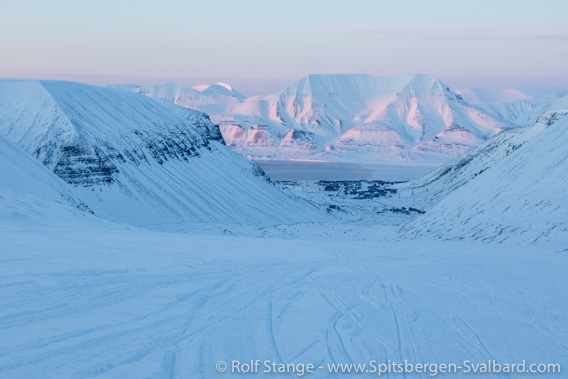
Lower Longyearbreen. This is the area where the fatal snow mobile accident happened yesterday afternoon (photo taken in late March 2022).
P.S. in an earlier version of this article it was written that the casualty was travelling with a guided group. This was not correct. She was travelling with a group with both local and non-local members.
Completion: On Monday, the name of the casualty was released by the authorities after consultation with her family. It was a Norwegian woman from Trondheim.
Sanctions will hit Barentsburg
The international sanctions introduced by many countries as a reaction to the Russian war of aggression and extermination against the Ukraine will also hit the Russian north including Barentsburg.
Murmansk is Russia’s most important harbour for coal export. According to Barents Observer, years of significant growth resulted in export of more than 16 million tons in 2019. Most of the coal was exported to the EU – mainly Germany – the UK and Israel. The growth led to plans for a new coal harbour in Lavna on the Kola peninsula. The current development involves major questionmarks for this project.
Compared to the Murmansk exports, coal production in and shipping from Barentsburg is small, and irrelevant to the world market. A bit more than 100,000 tons are produced annually in Barentsburg, of which something near 30,000 tons are used in the local coal power plant and the rest is for export. These exports are globally insignificant, but nevertheless important for Barentsburg in terms of economy and jobs. Of near 400 inhabitants, around 150 are working in the coal mine, including many Ukrainians.
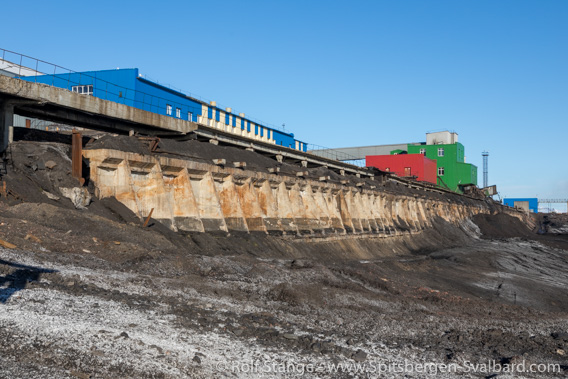
Coal storage and industry related to coal mining in Barentsburg: international sanctions will hit here as well.
Coal from Barentsburg was mainly sold to the UK in recent years, but it appears very unlikely that the United Kingdom will continue this trade. This would severely damage a major part of Barentsburg’s economical foundation. Tourism has been developed in Barentsburg in recent years, but this industrial sector has largely collapsed during the last two years because of the pandemic and now because of the war and associated sanctions, leaving coal mining as the only industry in Barentsburg.
Irritating interview of the Russian consul in Barentsburg
Last week – before the pictures of the cruelties in Butcha went around the world – the Russian consul in Barentsburg irritated the public with an interview with Norwegian media (nettavisen.no) saying the images of the extensive destructions in Mariupol were in some cases staged and in other cases fake. He called western media “fake news”, especially referring to Norwegian media, while pretending that Russian information is true. The article by nettavisen is Norwegian, but near the end it includes a video of the interview with the consul in English.
The inhabitants of Barentsburg seem to avoid political discussions both amongst each other and with media, as NRK found out during a visit to the settlement.
Charity: a heart for the Ukraine – handmade in Longyearbyen
As a charity, you can buy a pin in the shape a heart in the colours of the Ukraine in the spitsbergen-svalbard.com webshop. The pins are handmade in Longyearbyen and the entire returns are charity for victims of the Russian war against the Ukraine. Click here for more information.
Customs controls in Spitsbergen – because of Russian war against the Ukraine
So far, there have not been any customs controls in Spitsbergen. There was just no need: due to the regulations of the Spitsbergen Treaty, taxes are reduced. There is no value-added tax and no import taxes. Hence, there were no customs controls.
This is about to change.
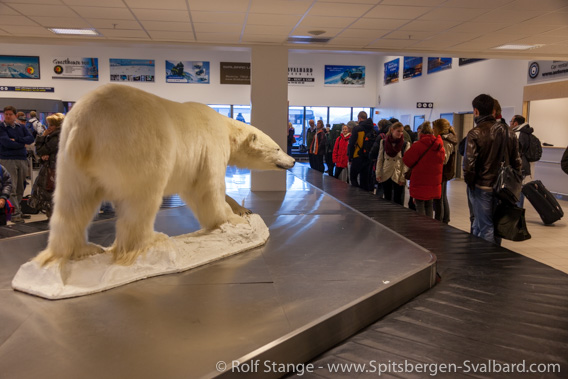
Longyearbyen airport: no customs control, just a polar bear.
This will change soon (no, the polar bear is not about to disappear).
The background is the Russian war of aggression against the Ukraine and the international sanctions introduced in that context. Norway wants to make sure that Russia does not use Spitsbergen as a logistical loophole to import goods that are sanctioned. This could be possible because there is no control of goods coming to Spitsbergen and there is ship traffic between the Russian settlement Barentsburg and Russia.
This is about to change. The Norwegian government instructed the tax authorities to establish a local presence and maintain controls as necessary, according to NRK. Customs controls are announced to be in place already in early May.
It is also announced that this measure is not planned to be permanent, but will be maintained as long as there is a need.
Polar bear warning system to be released
Norwegian authorities have announced a polar bear warning system in cooperation with the Norwegian Polar Institute and Elon Musk’s satellite-based communication system Starlink.
As a first step, the whole population of Spitsbergen’s polar bears will received microchips provided by Bill Gates. These chips include a micro-sender that sends signals that will be picked up by the Starlink satellites and forwarded to through ground stations to the Norwegian Polar Institute in real time. As a result, the position of each and every single polar bear in Spitsbergen will be known at any time.
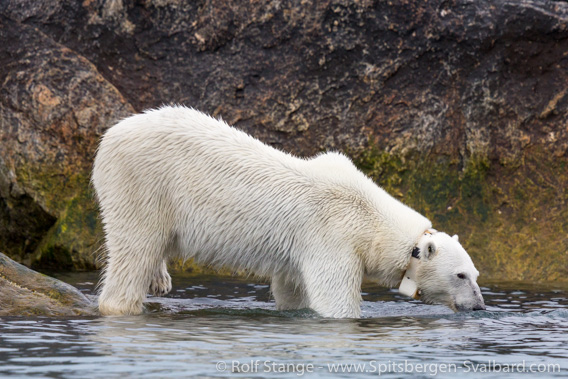
Female polar bear with tracker. The new generation of senders will be much smaller, which is also expected to significantly improve the well-being of the animals.
The public, however, will not have access to the data set as such, but users can download an app that works in a similar way as the corona-warn-apps, informing the user when a polar bear is in the vicinity. Fee-paying users of the pro version can even use a function to let the microchips installed in the ears of the bear blink brightly, to make it easier to see the approaching bear in the field – a feature especially useful during the polar night. All versions of the app will produce a loud warning signal when a polar bear approaches within 5 metres.
In the future it is planned to develop the system further so that the behaviour of polar bears can be controlled through the app, for example to make aggressive polar bears turn around and walk away peacefully.
The first version of the app is currently under development. The release of the final version is scheduled for April 01, 2222. It will then not be available here in the Spitsbergen-Svalbard.com webshop.
… bad times: rain and melting snow in the winter
Well, “bad times” is clearly a very relative description of life in Longyearbyen. We are having a good life. No bombs are falling from the sky. Just rain. But, hey … rain! In March! And far too much, and a large proportion of the white beauty around is is just melted and flown away during the last couple of days.
A strong low pressure system further south in the north Atlantic has pumped a lot of warm air up north. This warm air incursion brings wind, rain and melting temperatures. Far more of all of these than we actually appreciate.
Our little world up here is melting.

Longyearbyen: rain and meltwater turn streets into little lakes.
This was at least our impression for several days, wherever you turned the eye. Water was falling down from the sky, water turned the snow grey, then dark and finally into water, creating lakes on flat tundra areas. Water broke through the snow in rivers that should remain frozen for several months still.
Rubber boots were the best choice for a little walk. It happens quickly that you make one wrong step and your foot disappears in a deep hole of slush, a very cold and unpleasant mixture of snow and meltwater. On the other hand, it can be slippery and smooth as glass just a step further. It is very popular in Norway to use spikes. A great invention, they have certainly saved many people from broken legs and what not.

Drainages had to be created in many places to prevent the rivers from flooding.
Normal routine in May and June, but very uncommon in March.
For anything further away, any tours out into the arctic winterwonderland of Spitsbergen in the late winter: it is pretty much the only reasonable option to wait until Spitsbergen actually is a winterwonderland again. It wasn’t for days on end, and it still isn’t at the time of writing. Winter will beyond any doubt return. It is not gone, it is just taking a break. It will be colder again, the rivers will freeze again, lakes will turn into ice.
The question is if we get enough snow again to tour reasonably out there in the wild, filling the many dark gaps where the tundra is now free of snow. Let’s hope so, in the interest of all who are coming up here with dreams of the arctic winter. There are many of them in March and April.

Snow mobile routes have turned into slushy snow swamps and lakes. If you drive here, you risk getting stuck and damaging the vegetation under the slush.
Until the snow melt comes in May and finishes this wintern for good.
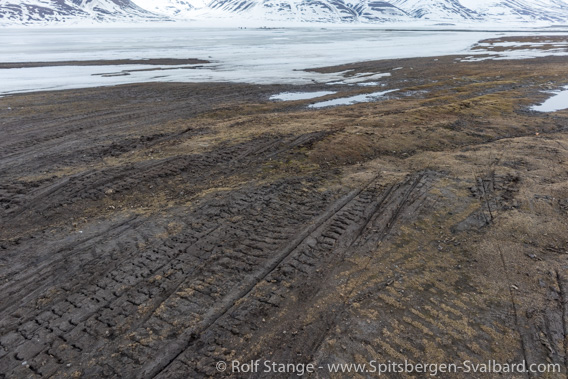
It is, for good reason, not allowed to drive on natural ground unless it is frozen AND snow-covered. There are those who take a liberal approach to this rule at the end of the season or during warm weather spells, to put it mildly – although it is legally binding. The result looks like this and it will take many years without further disturbance to for the vegetation to recover (Adventdalen, next to the road. Picture taken in june 2019).
The question will inevitably come up: is this now weather or climate change? My short answer: it has aspects of both. Weather and climate are hard to separate when it comes to any given meteorological event. Both are just different perspectives, different time scales, for pretty much the same collection of phenomena which altogether describe the atmosphere, especially its lower layers (that’s where we usually are). Such as temperature, precipitation, wind, air pressure and humidity, to name some of the most important ones. Weather is what you can see, feel and measure here and now. If you collect the same data over many years and turn them into averages and other statistical values, then you take the climate perspective.
So, in this given case, it is hard to say if it would have happend without climate change. Science has made important advances in recent years regarding such questions, so it would be interesting to hear an expert’s opinion or even see the results of scientific modelling of this week’s warm air incursion in Spitsbergen.
All I can do here is try to come up with some more or less educated guessing. The tendencies that climate change create for this part of the Arctic appear to be pretty clear: more frequent weather changes, more strong wind, more precipitation, especially more rain in the winter.
There are those who will say now that winter rain was not completely unheard of 100 years ago, and yes, that is true. But both the frequency and the intensity of these events are increasing now, and current climate change makes an important contribution to this development, or rather: the decisive one.
So, chances are that we would not have had this week’s warm air incursion up here without climate change, or at least that it would have been much less intense. We have had days of rain and temperatures up to around 5 degrees centigrade – above freezing! In March! I still can’t really believe it.
Also locals who have seen many Spitsbergen winters watch the weather with astonisment and very little amusement these days. And those who came up exactly this week to enjoy the arctic winterwonderland – well, what can I say. My pity is with them.
- gallery anchor link: #gallery_2193
Click on thumbnail to open an enlarged version of the specific photo.
Local tourism organisation asks members not to spend money in Russian settlements
Against the background of Putin’s aggressive war in the Ukraine, the local tourism inter-trade organisation Svalbard Reiselivsråd encouraged the member companies not to spend money in the Russian settlements in Spitsbergen, Barentsburg and Pyramiden.

Popular in the past, now controversial: the brewerey in Barentsburg.
It was just a few days ago that Svalbard Reiselivsråd initially made a different decision, arguing that boycotts and sanctions should be measures between governments and states, but not on a local level. The recent turnaround came because many pointed out that the income generated in the Russian settlements benefits the owner of the settlements including all touristic offers and services: the Russian state-owned Trust Arktikugol, or in other words: the Russian government, which now leads a brutal and illegal war in the Ukraine.
Svalbard Reiselivsråd does not advise against tours to Barentsburg and Pyramiden, just from spending money there. Tours especially to Barentsburg used to be very popular before the recent large-scale Russian invasion started. These excursions usually included a local meal and an opportunity to buy souvenirs, including locally made ones. Many tour operators will now stop this practice.
But not all: also the new decision is controversial. There are those tour operators who argue that such boycotts will hit the wrong people, namely the local population – which includes many Ukrainians – rather than the regime in Moscow.
Svalbard Reiselivsråd makes only recommendations to the member companies, but these recommendations are not binding. Every tour operator will decide individually if they will continue tours to the Russian settlements and if they continue to buy and pay for local services.
Sun festival in Longyearbyen
The sun festival (solfest) is an important highlight in the annual calendar for many in Longyearbyen. It is traditionally celebrated on 08 March, when the first direct rays reach Skjæringa, the oldest part of Longyearbyen. On this day, a large crowd comes together at the stairs of the old hospital (which does not exist anymore) close to the church.
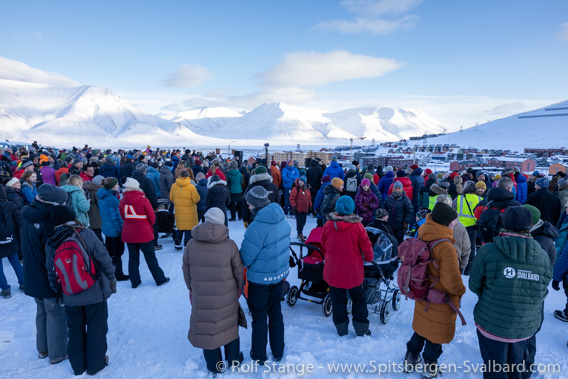
Sun festival (Solfest) in Longyearbyen.
This was also what happened in good tradition this time, although clouds on the southern horizon threatened to spoil the event. Many locals and certainly also a number of tourists gathered to celebrate the return of the light. The traditional programme includes singing, and when the sun was fighting to get through around 12.45 hours, she was lively cheered to until she indeed finally came out, to everybodies great delight!
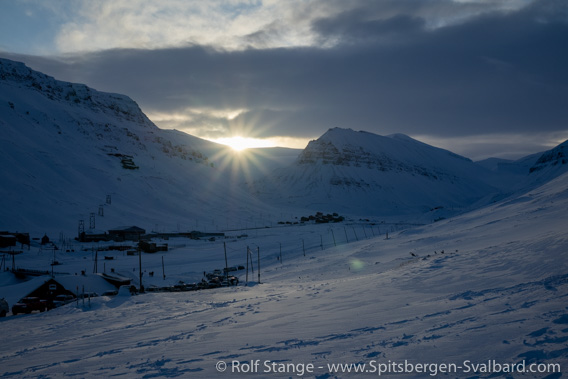
Sun festival in Longyearbyen: “Here comes the sun” 🙂
Talk of luck – soon, the horizon disappeared again behind a grey curtain of clouds.
The sun festival is actually nmore than “just” the 08th of March, it is a whole week with a series of various cultural events. Some of them, such as the traditional revye that always comes with the solfest, have to be postponed by several weeks because too many of the artists are currently fighting Covid-19 🙁
Local tourism inter-trade organisation against boycott of Russian settlements
While the Russian war is raging in the Ukraine, many are asking in Longyearbyen how to deal with the Russian neighbours in Barentsburg, where part of the population is Ukrainian, and the largely abandoned settlement of Pyramiden.
The important winter tourism season has started, and the many tourism companies in Longyearbyen were looking forward to the season after two very difficult corona years. Day trips to Barentsburg have, so far, been amongst the most popular offers; Pyramiden is also an important destination, although less frequently visited than Barentsburg because if it further away.
Now many in the industry are wondering how to deal with these offers considering the Russian aggression, war and crimes in the Ukraine and the international reactions. The local tourism inter-trade organisation Svalbard Reiselivsråd has taken the question upn and discussed it between their members and with authorities.

Barentsburg: usually a popular destination, now controversial.
As a result, Svalbard Reiselivsråd does not recommend to boykott the Russian settlements. The organisation argues that sanctions should be measures on a governmental level but not on a local, private sector level, where a boykott is more likely to hit people locally rather than the Russian government and others who are responsible for the current war and crime in the Ukraine. Svalbard Reiselivsråd indicates that they understood from Oslo authorities that a normal relationship is desired on a local level, according to Svalbardposten.
Some members had argued for a boykott of the Russian settlements, and clients had cancelled their bookings. According to Svalbard Reiselivsråd, it is up to every company not to offer trips to Barentsburg or Pyramiden, and it is anyway up to every tourist to book a tour to these settlements or not.
Black February
Of course it had been my intention for a while already to write again here. But life in Farmhamna is mainly happening offline, and that is good.
And now the world isn’t anymore what it used to be. The whole population of Farmhamna (currently two people) is deeply shocked about the news that reach us here. It would just feel completely out of place to write about the beauty of the nature here in the far north and about the simple, but good life in a remote trapper station while the world is on fire.
It is about 40 kilometres from Farmhamna to Barentsburg as the fulmar flies. We can see the light of Barentsburg reflected by low clouds in certain weather conditions. It is not far at all. Barentsburg is a Russian settlement, but with many Ukrainians amongst its 300-400 inhabitants. So far, Russians and Ukrainians were living there together peacefully, also after the Russian occupation of the Krim peninsula and the conflict in the eastern Ukraine since then. How do people feel there now? How are they, with the knowledge about the situation in their respective home countries? Impossible to imagine for me. Sysselmester Lars Fause is in regular contact with Barentsburg, following normal routines, and says that it is a “good and normal dialogue”, without going into further detail.
So I finish my contributions here for February with the following picture, which is currently often shared in social media to express the horror about the situation, protest against the Russian invasion and war in the Ukraine and complete digust for those who are responsible for it.

The Ukraine
Data cable between Spitsbergen and mainland Norway damaged by human action
The damage that occurred to one of the two communication cables that connect Spitsbergen to north Norway a few weeks ago attracted a lot of public attention (click here for more information). The case is by no means settled, but the owner of the cable, Space Norway, and the responsible police agency of Troms in north Norway have been in the area and were able to gather first data with an underwater robot.
According to NRK, the police told Norwegian media that human action appears to be likely as the cause for the damage. Natural influences seem less likely now.

Making a phone call in the settlements of Spitsbergen is done in a more modern fashion than pictured here. And it’s not just about phone calls.
But almost everything depends on the deep sea data cables to the mainland.
Nothing was revealed about the nature of the damage or even possible responsible people or groups; it was only said that there are so far no suspects. It is also not yet publically know in which depth the damage occurred. The cable section in question is about 100 km long and leads from the relatively shallow shelf on the west coast of Spitsbergen to deep sea areas.
It is actually not the 2 cm strong cable itself that is damaged but its power supply.
Repair works are scheduled later this year, in spring and/or summer.
Norway opens up
Norway discontinues most corona restrictions as of today (1st of February) 2300 hrs local time, according to a governmental press release.
This includes significant easements within education, culture and gastronomy, but also for travellers: international travellers do not need to get tested at the border directly after arrival anymore. Fully vaccinated travellers with an accepted vaccination certificate and recovered people with appropriate documentation may enter without test; those who do not have this status need a test taken before departure. Everybody including Norwegian citizens still need to register online before arrival.

corona testing station at Oslo airport Gardermoen: here seen calm, but often very busy.
Soon it will mostly be reliably calm here.
(additional decoration digitally added by the author).
For people travelling to Svalbard, the requirement to get tested in Norway within 24 hours before departure is discontinued for registered lcoal inhabitants as well as fully vaccinated travellers and those who have recovered from a recent Covid-19 infection (accepted documentation needed in any case). The requirement to carry out a self test within 24 hours after arrival is still in force.
Everybody is still asked to keep a distance of one meter or to wear a mask wherever it is not possible to keep this distance.
The Norwegian government plans to discontinue all corona restrictions until 17 February unless new and currently unforeseen developments require a new change of plans.
The state of affairs
The new is already nearly 4 weeks old. Not too much has happened in Spitsbergen that has really shaken the world, but nevertheless it is time to have a look at the state of affairs.
C & O in Longyearbyen
C as in corona, O as in Omikron – I guess there is hardly anyone who can still hear it without getting turned off. And who will be surprised that C & O are now well established also locally in Longyearbyen? Probably nobody. The numbers of positive tests is well up in two-digit numbers – within a population somewhere near 2500. And it is definitely not just about travellers who just came up with „importsmitte“ (imported infection). The virus is circulating locally, including the school.
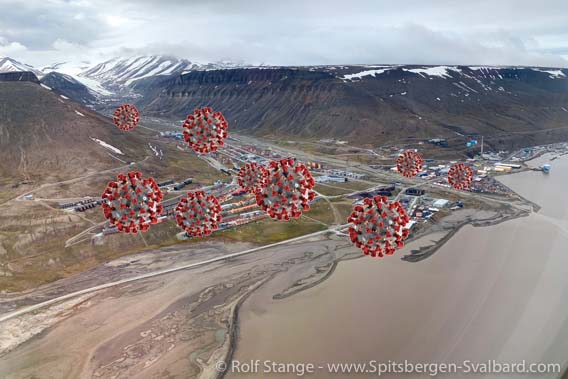
🙁
Nearly everybody travelling up to Svalbard is obliged to take a negative test done in Norway within 24 hours before departure (and another one after arrival), something that locals – population, economy, politicians – are not amused about at all, also considering that this is not the case elsewhere in Norway. And there are those who ask why Svalbard gets a different treatment than the rest of the country. The tourism industry is getting more and more nervous about the important winter season, which has already been largely lost in to consecutive years.
No sabotage on the cables
No, this is not about the deep sea cable that connects Svalbard to the rest of the world which was damaged a few weeks ago. It is still uncertain what has actually happened to it and it will take some time until the damage is located, let alone repaired. But the functionality has at least been restored, so there is redundancy in the communication again and the whole pressure isn’t just resting on the second cable alone anymore.
In this context, the initially mysterious case of a damaged cable on the sea floor off north Norway was also discussed. Sabotage was at least not excluded in either of these cases, and one had to exercise a bit of self discipline in order not to think of Norway’s big and currently rather ill-tempered neighbour in the east (no, not Sweden). But at least for the case near the islands of Vesterålen in north Norway, sabotage seems rather unlikely now, as NRK reports: the still „missing“ bit of the cable was „found“ – indeed it turned out that the part of the cable that was torn off and later found in a distance of 11 kilometres from the original location, was actually complete, so nothing was missing anymore. This was established after the length of the cable could be measured more precisely.
An investigation of the ship traffic in the area at the time in question has resulted in information that points to a fishing vessel as the cause for the cable clutter. This had initially been considered unlikely as it was believed that such an incidence could not have happened unnoticed and that the crew would have reported it, but this has apparently not been the case. As unpleasant as the whole affair still is for everybody involved including those who don’t get the data they need for their scientific work, at least this is one potential strain off from international relations which are difficult enough as they are.
And as mentioned above, it remains to be seen if there is an equally harmless (at least from a point of international politics) explanation for the case of the Svalbard cable.
Polar Permaculture: neither perma nor culture
The business was neither perma(nent) nor was there sufficient culture in it, at least looking at the formal side of affairs: Polar permaculture was an eco-friendly horticulture business growing for example kitchen herbs in a dome in Nybyen. Local and environmentally friendly food production was and still is an idea that many will sympathise with (including this author). But in this case, the attempt, which seemed to work successfully for a couple of years, came to a rather sad end as the company went bankrupt during the corona crisis in spite of public aid. So far so understandable. But the problem is that the whereabouts of substantial amounts of money, from public and private sources, could not be traced – and 2 million Norwegian kroner (about 200,000 Euro) are not small change, obviously. It turned out that „chaotic“ seems to be a rather mild description of the accounting within Polar Permaculture. The Sysselmester is investigating the case according to Svalbardposten, considering to open a legal case against the former company.
And other than that?
That’s it for the moment.
Data connection cable to mainland damaged
Many, many years ago, ships were needed to send messages from Spitsbergen to the world and vice versa. The wireless telegraph station built in 1911 at Finneset made communication considerably more efficient. Further techical upgrades followed throughout the 20th century.
But this kind of connection, although perfectly fine for the everyday needs of mining companies, expeditions and fishing and other ships, was far from good enough for the traffic that arose when SvalSat was established in 1997: a station with a collection of satellite antennas to send data to satellites and receive data traveling the opposite way. The number of antennas at SvalSat has increased ever since and is now amounting to something near 100.
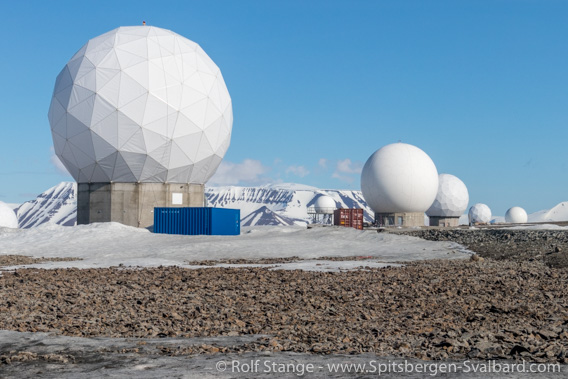
Satellite antennas of SvalSat on Platåberg near Longyearbyen.
As customers like NASA and ESA don’t like to wait until a data DVD or USB stick is shipped out to them, a fibre cable was laid to the mainland in 2004 to transport large volumes of data in real time. It is actually a set of two indipendent cables to create redundancy and thus a robust structure. Since these cables exist, Longyearbyen has super-fast internet (although the user experience of more mertals may occasionally be different).
The two cables on the sea floor are a very important and sensitive bit of infrastructure. Almost all communication of all of Spitsbergen’s settlements depends on them, as well as the data traffic that is going through SvalSat: controlling satellites in polar orbits and receiving their data when they are needed. Navigation, communication, science, weather – the whole lot, everything that satellites do these days. Obviously an important bit of global infrastructure.
Last Friday, one of the cables was damaged in the early morning, as the operating company Space Norway notified in a press release. A sea-going cable laying vessel is needed to repair the damage, and it will take time until this is done.
The second cable is enough to cater for all data traffic and there are no restrictions as long as it is operative. But there is no further redundance, and a loss of the second cable would have huge consequences. A crisis management group had a first meeting in Longyearbyen to discuss scenarios “in case”. Officials emphasise, however, that there is no reason to believe that a loss of the second cable is likely to happen.
The damage seems to have occured at a distance between 120-130 km from Longyearbyen, in an area where depth is falling from the shallower shelf to the deep sea. The continental shelf is an area where huge mass movements naturally occur from time to time, so the damage may have been caused by a natural event. But no further details are known so far, and authorities do not exclude criminally relevant action of third parties, according to NRK.
The case reminds of the mysterious loss of a cable connection of research installations on the sea floor off north Norway. Last year, the “Lofoten-Vesterålen Meeresobservatorium”, or short: “LoVe” suddenly turned black. LoVe is a civilian research facility designed to collect a rather comprehensive set of high-resolution data of various sorts, including acoustic data. LoVe is, in other words, capable of recording submarine traffic at least to some degree. It turned out that no less than 4 kilometres of cable were removed. 3 out of these 4 km of cable were later found in a distance of a good 10 km from the original site. A natural cause for the event can, as of now, not be excluded, although all options considered (including currents, giant squid or whales) sound more or less bizarre. Bottom trawling can not be ruled out either, but it is hard to imagine that this would have happened unnoticed.
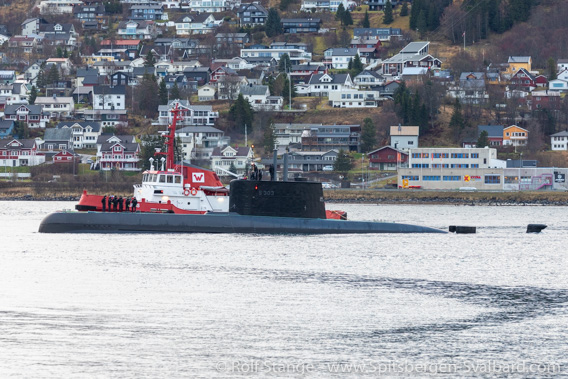
There is a lot of submarine traffic off Norway. Not all of them operate as much in public as this submarine that is here seen being towed in the harbour of Tromsø.
In this context, remarks have been made that Russia is technically capable of operations on the sea floor at relevant depths. Norwegian authorities including the secret service are involved in the investigations, as was reported by NRK and international media such as German SPIEGEL Online.
These cases shed a different kind of light on the desire of the Norwegian military to control high-resolution mapping of the Norwegian sea floor including Svalbard and Jan Mayen.
News-Listing live generated at 2024/April/23 at 14:05:50 Uhr (GMT+1)
